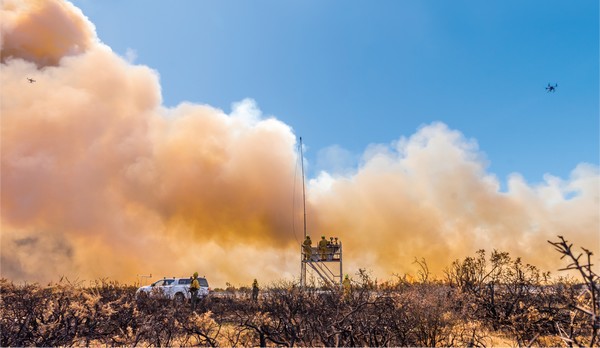Six experimental burns carried out by Scion’s Rural Fire Research team have resulted in never-before-seen insights into fire behaviour.
The burns are part of a series of experiments in differing vegetation types, designed to test a new theory of fire spread based on convection.
The six burns conducted in gorse scrub in the Rakaia Gorge, were highly instrumented with over $1 million in specialist camera equipment. Infra-red and visual footage captured by drones has provided new insights into the patterns of up- and down-drafts created by the fire front. The data collected across these fires, and experimental crop stubble fires undertaken in 2018-19, have both supported the new theory of fire spread. The next step will be to test it in standing wilding pines.
Fire and Emergency New Zealand, Integrated Risk Manager Darrin Woods says, “The learnings from Scion’s research burns will contribute to firefighter and community safety by changing the way we predict and respond to wildfires. The burns are also an invaluable opportunity for firefighters to practice their skills and observe extreme fire behaviour while in a highly managed environment.”
Ultimately, the new theory and data generated by the experimental burns will fundamentally change how firefighters are trained regarding heat transfer and fire spread in wildfires. The new information will be incorporated into training and fire prediction models, giving fire managers information they need to improve firefighter and community safety, and reduce loss from wildfires in New Zealand and around the world.
Completing the research burns also improves our understanding of the physical processes contributing to fire spread and ignition of fuels ahead of the flame front. This is increasingly important as changing climate drives up the number of extreme fire risk days and frequency of extreme wildfires, which are unpredictable and deadly.
But why is it necessary to light fires to study fire? Fire scientists are testing a new theory about the role of heat transfer mechanisms in how fire spreads. Studying wildfires under closely controlled, highly uniform laboratory conditions is not very realistic. The best way to study fire behaviour is in real world conditions.
New Zealand is one of the very few countries where large experimental burn projects are still possible – largely due to the relationships built up by the Scion rural fire research team with Fire and Emergency New Zealand, the Department of Conservation, forestry companies and other land owners. Burns attract worldwide interest from fire researchers. Gorse burns were observed by researchers from the US Forest Service, San Jose State University and the University of Canterbury, as well as the Scion fire team. The amount of instrumentation, and the number of cameras and drones watching and recording ensured the recent fires were, according to the research team, the most closely observed burns in New Zealand to date.
Throughout the experimental burns, the research team also measured turbulence across a range of scales from the atmospheric scale right down to the fine-scale within the flame front. The team wants to understand the links between turbulence at these different scales, and how it influences the convective processes occurring at the fire front that drive fire spread.
The Extreme Fire Research Programme runs from 2016 – 2021.
Links
Drones provide added dimension to monitoring experimental burns blog post
You’ve got to burn to learn
Gorse experimental burns successful
Funders: Ministry of Business, Innovation and Employment, Fire and Emergency New Zealand, Forest Growers Research, New Zealand Defence Force and the Department of Conservation, in-kind support from Federated Farmers
Collaborators: United States Forest Service, San Jose State University and University of Canterbury

